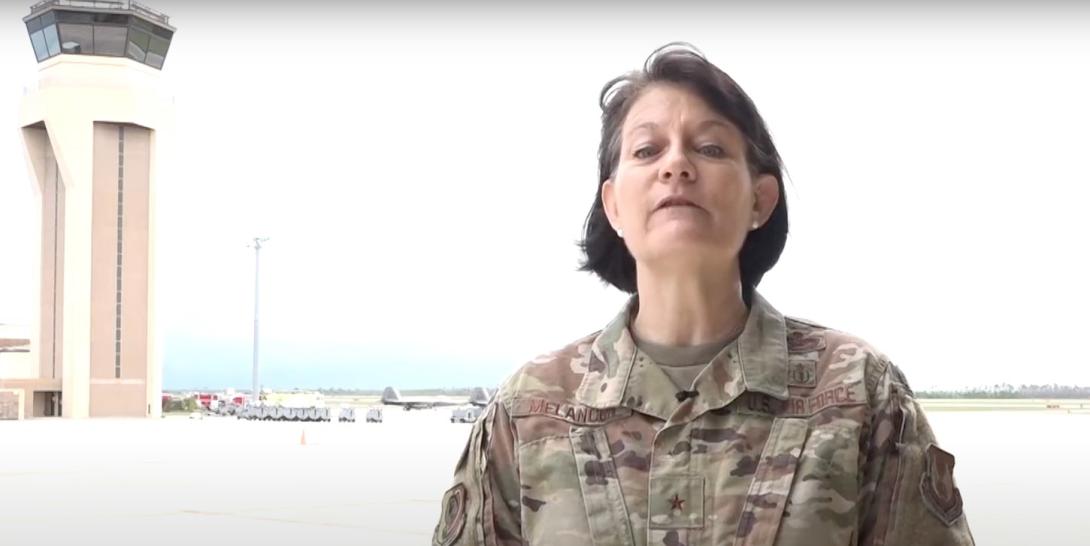Crafting the Base of the Future
As the Air Force holds its innovation push via AFWERX 2020, an annual event to draw advanced solutions to key challenges, the service is targeting capabilities to improve base facilities and operations via its comprehensive Base of the Future effort.
One of the initial focuses of the Base of the Future effort is to rebuild Tyndall Air Force Base, Florida, explained Brig. Gen. Patrice A. Melançon, USAF, executive director, Tyndall Air Force Base Reconstruction Program Management Office, U.S. Air Force, speaking at last week’s Fusion event hosted by AFWERX.
Tyndall was devastated in October 2018 by Hurricane Michael, a Category 5 storm that caused a reported $5 billion in damage, obliterating the flight line tower and leaving the 79-year-old base with only one working aircraft hangar. After reconstruction and advancements, the base will house the F-35 Lighting II aircraft as early as 2023, the general said.
With the help of AFWERX, the Air Force is pursuing a model of bringing innovation to Tyndall, a method that will be applied to other Air Force bases, as well as other service installations across the U.S., Gen. Melançon shared. That model will also be applied to the acquisition process. For Base of the Future, AFWERX has posted a commercial solutions opening, or CSO, which acts as the solicitation vehicle and allows for traditional Federal Acquisition Regulation-based contracting and nontraditional other transaction authority (OTA) procurement. The Base of the Future CSO is also available to other services and organizations, the general emphasized.
“If you represent an office within the government that is interested in some of the technology that you see during Fusion, find your contracting officer and together you can use this Base of the Future CSO to get after that technology and place it on the appropriate procurement instrument,” Gen. Melançon said. “There is training available from SAF/AQs [Assistant Secretary of the Air Force for Acquisition] Rapid X contracting team to assist contracting officers in utilizing this CSO, so that the right technology solutions find the right government end users empowering us to deliver an ever-evolving Base of the Future not just at Tyndall but across the DOD as a whole.”
So far, the Air Force is looking to employ smart technologies, including advanced sensors and artificial intelligence, to provide proactive maintenance capabilities and reduce costs. At the same time, the service would have to improve how it integrates the tools into information technology networks to be able to conduct data aggregation, as well as employ effective cybersecurity protections. The Tyndall PMO also is considering smart technology applications for perimeter defense, such as gunshot detection systems that interact in real-time with the base’s law enforcement.
“These sensors range from sound or vibration signatures that can detect initial failure of a motor and potentially provide initial diagnosis, to leak detection in facilities or the water distribution system,” the general observed. “We want to bake in the tools that will allow us to do maintenance at what we're calling the sweet spot, where we can minimize repair costs and actually extend the useful life of our built infrastructure. And while these sensors are a fairly mature technology, the rest of the equation is not.”
Leaders are working with the Air Force Research Laboratory and the Air Force Civil Engineer Center on how to integrate such equipment and systems into buildings. The center is developing a prototype installation resilience operations center to help achieve conditions-based maintenance at initially at Tyndall, and then to all bases. “Eventually we'll include data from all of our bases and be able to look at trends across a major command, a particular geography or the entire installation,” Gen. Melançon stated.
Advanced power solutions to improve Tyndall’s energy resiliency that are under consideration are microgrids, self-healing grids and alternate energy resources, as well as the ability to conduct operations disconnected from the local power supply.
Moreover, once the F-35s are fielded to Tyndall, leaders want to have in place smart technology that will interact with the plane’s Autonomic Logistics Information System (ALIS). ALIS provides enterprise-wide trends, as well as real-time feedback about aircraft health and maintenance information. “While the aircraft is still flying its mission to a technician on the ground related to potential maintenance or checks that might be required when the aircraft does land,” the general specified.
Additionally, the base is considering augmented or virtual reality glasses to assist aircraft technicians in their examination of engines or landing gear, or for supply chain applications.
“We're considering the entire supply chain and how we might leverage data and technology to optimize our purchasing, storage and delivery,” Gen. Melançon. “Remember that technician in the maintenance hangar who's just gotten an alert from the F-35, imagine her or him taking their tablet and with a few quick taps they order up whatever tools and supplies are needed, and that gets sent to the warehouse and the needed tools and supplies are put on a drone and flown out to the parking spot where the aircraft has just landed.
“We're not quite there yet but that is definitely where we're headed,” she stated.





Comments